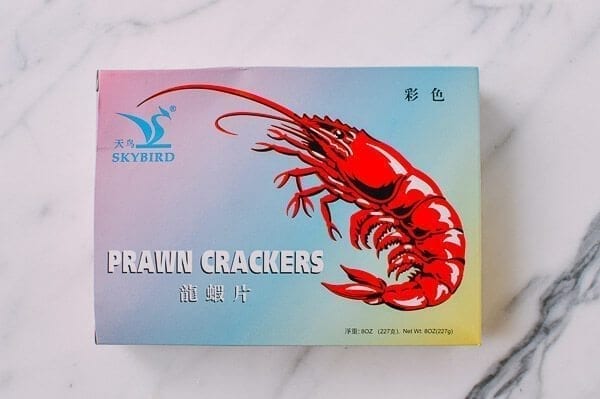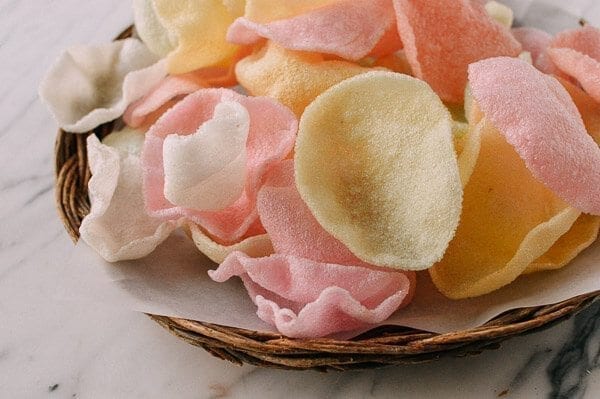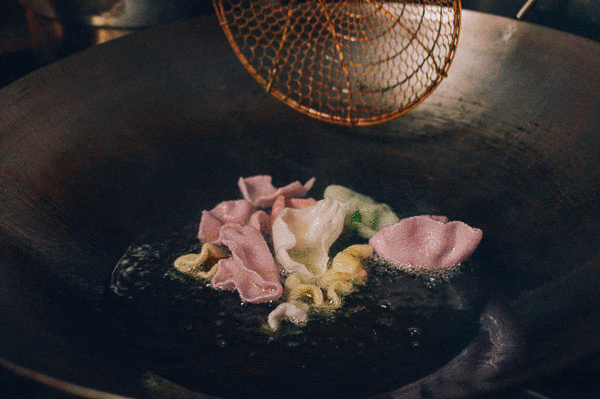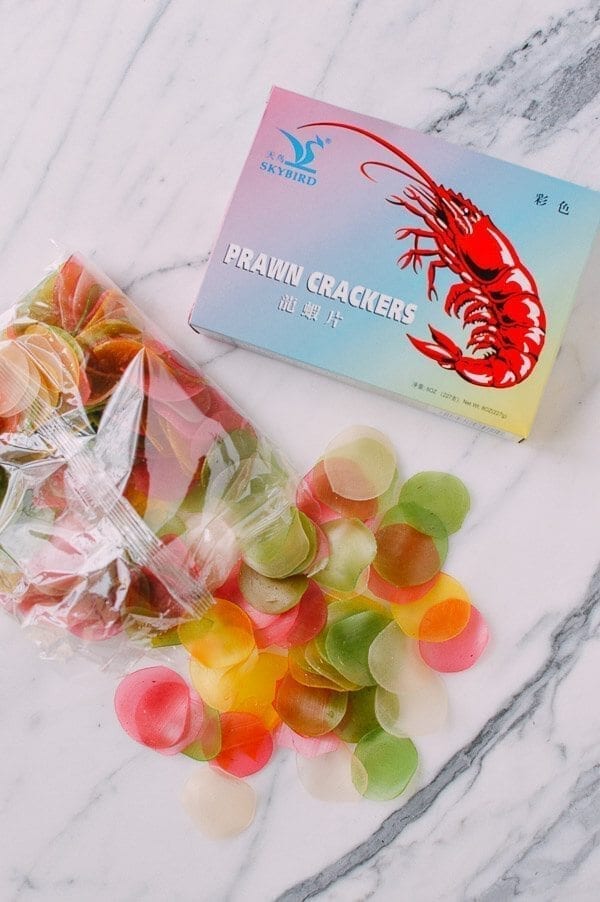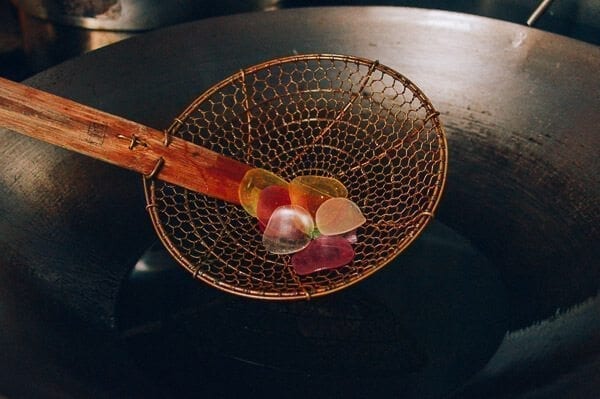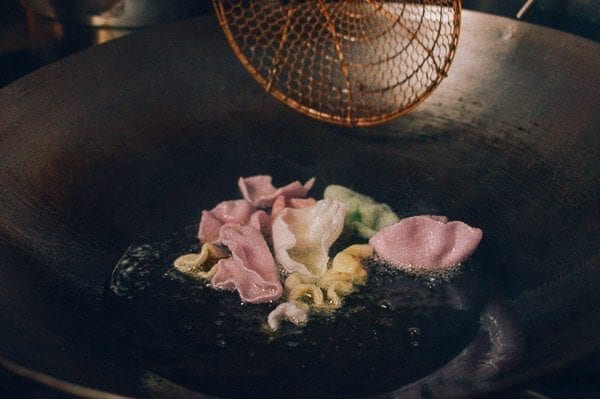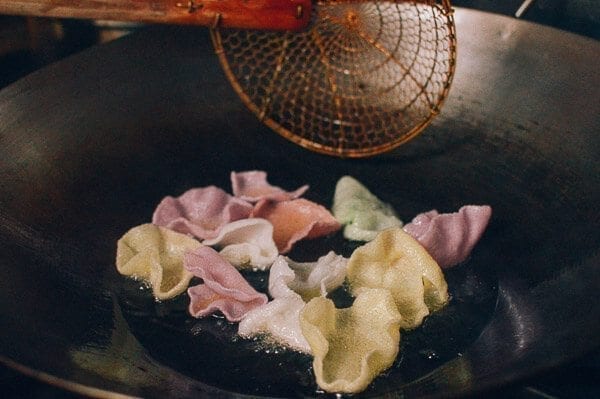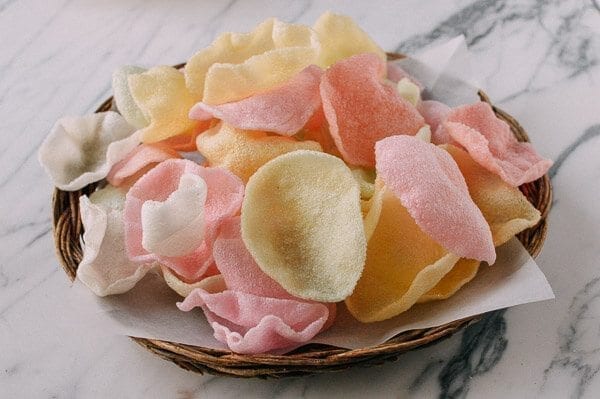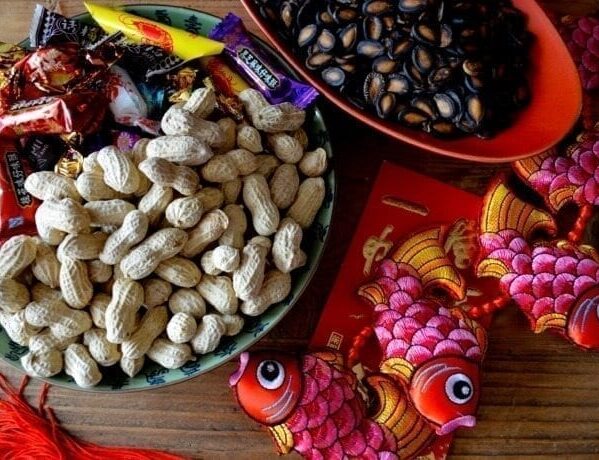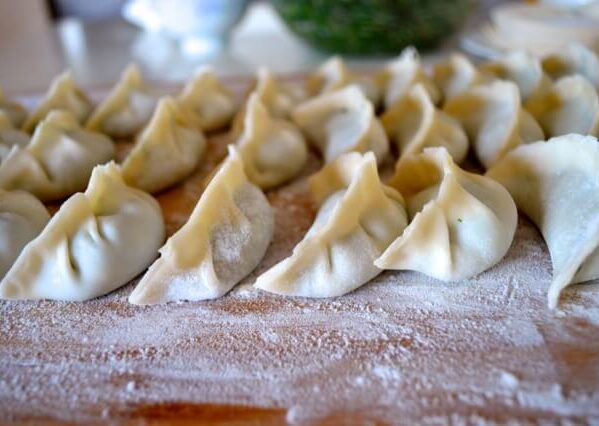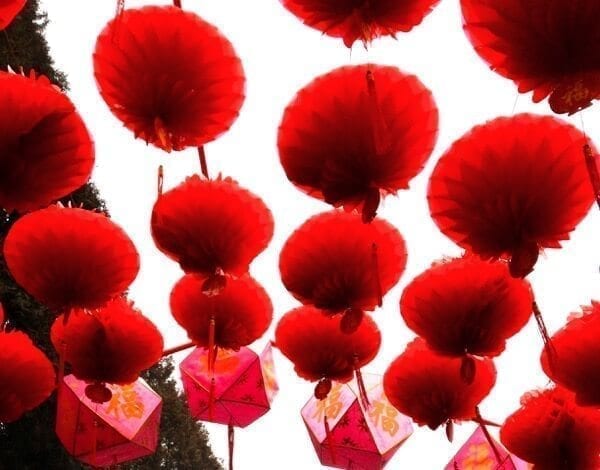When I was a kid, prawn crackers (sometimes also referred to as fried shrimp chips or “Ha Peen” in Cantonese) were one of my first waking thoughts on Chinese New Year morning. It might sound like an exaggeration, but it was reality for a chubby kid like me, who was also an early foodie!
Later, when my sisters and I were in our pre-teens, waking up on Chinese New Year’s day was always exciting, because if we didn’t have anything important happening at school, we would usually take the day off. I would look for something red to wear (or risk being sent back to my room to change) and happily made my bed knowing I was playing hooky from school that day.
Mom and Dad would try to take the morning––if not the whole day––off work, and by the time we got out of bed, the kitchen was already stirring with activity. Whole poached chicken, Pan-Fried Fish, and Roast Pork Belly were already being prepared to honor our ancestors. My mother would arrange these cooked Chinese New Year dishes with three bowls of rice and chopsticks on the table. A stack of fresh tangerines, with leaves still attached, adorned the table along with plates piled with candy and dried fruit. The aroma of Chinese incense filled our small apartment as we all silently invited our ancestors to the table for this annual meal, and we would ask them to watch over our family in hopes of a healthy and prosperous Lunar New Year.
Dad would also be frying colorful shrimp chips or fried prawn crackers, the subject of today’s post, and preparing the ingredients for the vegetarian dish, Buddha’s Delight (or Lo Han Jai). The Lo Han Jai with a bowl of rice was always the mid-morning meal, and a basket of shrimp chips disappeared quickly thanks to me and my sisters.
After the Chinese New Year meal, we would get our first red envelopes (hong bao) of the year and eagerly ask if any guests would be coming for dinner. This would mean more hong bao for us, as anyone married is obligated to give lucky money to kids for good luck. For our Cantonese elders, all that was required from us was a polite “Gung Hei Fat Choy!” This routine lined our pockets with cash!
I remember we would retreat to our rooms to check our loot as we retrieved the red envelopes. My older sisters had the responsibility of reporting back to my mother how much each person gave us in their hong bao, so she could appropriately return the favor to their kids. What I do remember is that my mother was very generous with the hong bao she gave out, and we would usually get the same back.
This was a huge deal and a big windfall for us kids. Each of us had our own plans for our loot. My haul would usually go towards Cox model airplanes, mini-bikes, or snowmobile repairs. As for my sisters, they saved much of their money, because when I was broke after my spending spree, they happily took on new roles as bankers, and they tended to collect interest.
At the end of this post, we’ve included some good practices for giving hong bao, some rules of engagement with family and friends during Chinese New Year week, and what our family would typically serve for dinner, so be sure to check those tips out!
For now, on with the preparation of the prawn crackers!
Prawn crackers (aka shrimp chips) were a fun treat, and I never missed the opportunity to see these prepared. These curious-looking chips looked a little like plastic craft items one would use in 2nd grade art class, but when dropped in oil, the magic happens, and they turn into the most delicious things any kid could ever eat.
You can buy prawn crackers at a local Asian or Chinese supermarket, but they are also available for purchase online. For more details, see our Chinese Dry and Preserved Ingredients page.
To make these traditional Chinese prawn crackers, You’ll need:
- 2 cups of vegetable oil, for frying
- 1 box of shrimp or prawn flavored chips (colored)
Heat the oil to 325 degrees Fahrenheit, and adjust your burner to maintain a constant temperature. You can use a thermometer to monitor the oil temperature for optimum frying.
Prepare a sheet pan by lining it with paper towels. You will also need a spider or a large spoon to handle the shrimp chips when frying.
Place 8-10 chips in the spider and drop them into the hot oil. Give them a gentle stir. Almost immediately, you will see the chips expand and float to the top of the oil.
Use your spider to quickly scoop them out of the oil before they get scorched or burned. Shake off as much of the excess oil as possible, and transfer them to your prepared sheet pan. Fry the chips in batches until you have enough, and transfer the cooled chips to a basket and serve. The kids will love them!
Prawn Crackers and Chinese New Year Dinner Tips
Now, if you need some additional tips on how to prep for Chinese New Year, here are more details on a typical Cantonese meal my family would make for dinner on Chinese New Year’s day:
- Whole poached chicken, Pan Fried Fish, and Roast Pork Belly were the first dishes prepared for honoring the ancestors.
- We would often have one or more seafood dishes, like Ginger Scallion Crab, Cantonese Lobster, or fresh Clams with Black Bean Sauce.
- Every year, without fail there were a couple of traditional dishes that were sure to show up on the table, like Dried Oyster with Black Moss and Braised Pork Belly with Arrowroot.
- Our green vegetable dish would be a simple one like Stir-Fried Bok Choy.
Check out our latest Chinese New Year recipe roundup if you are planning a dinner for guests. Chinese New year parties go on for 1 to 2 weeks after Chinese New Year’s Day, so you have plenty of time to enjoy with friends and family!
Giving and Receiving Red Envelopes (Hong Bao) For Chinese New Year
We thought it would be useful to put together some tips and etiquette for how to give out and receive red envelopes for the Chinese New year holiday.
- Get new bills from the bank if you can. “New” everything is good on Chinese New Year.
- The general rule is that children/unmarried young adults always get a hong bao from each married couple.
- Married folks should also be sure to give hong bao to their parents and any one else in older generations, like grandparents or great grandparents.
- The amount of money you put into each hong bao is a personal decision and depends on how close you are to the recipient, as well as the number of kids present at the gathering. It can generally range anywhere from $5 to $20.
- If kids are absent for whatever reason, you are not expected to give them a hong bao, especially if they are not family. Although if you know they have siblings, it’s always nice to give a red envelope to mom and dad to pass along to the children who couldn’t make it, especially if you know the little gal or fella!
- Make sure to keep the kids’ red envelopes good and separate from those reserved for the elders!
Dos and Don’ts for Chinese New Year
There are a lot of funny traditions and suspicions associated with celebrating Chinese New Year. Here are all the do’s and don’t’s you should follow for a happy celebration and hopefully some extra luck heading into the new year!
- As a dinner guest, do bring gifts of food, candy, oranges, fruits, and gift-boxed cookies—all good candidates. Be sure you don’t arrive empty-handed, as this is considered the height of rudeness this time of year!
- Your host will also make sure that you don’t leave empty-handed, so you can politely refuse once or twice if you don’t want to leave with anything, but graciously accept if they insist! This exchange of gifts during Chinese New Year visits is a longtime tradition.
- If you are going to someone’s house, then be prepared with red envelopes, especially if there are children. A “Happy New Year!” or a simple “gung hei fat choy” from any kids is your cue to reach into your pocket and give up the red envelope!
- Do compliment the hosts on the food and their festive decorations—everyone wants to be happy and know their guests appreciate what they have done to prepare the Chinese New Year gathering.
- If you’re hosting, make sure you DO NOT serve any squid or calamari, as a stir-fried squid dish is synonymous with losing your job or being fired!
- Be very careful handling plates and glassware, as it is very inauspicious to break anything, especially at someone else’s house.
- No arguments, fights, or profanity, even if you lose at the mahjong table, or you will get stares from the elders.
- Don’t talk about any misfortunes or inauspicious events that day––save it for another day.
- Don’t sweep your floor, as you may be sweeping away all of your fortunes! (Yes, this is a real superstition.)
Happy New Year everyone! We all hope you have a great time celebrating with family and friends.
Fried Prawn Crackers for Chinese New Year
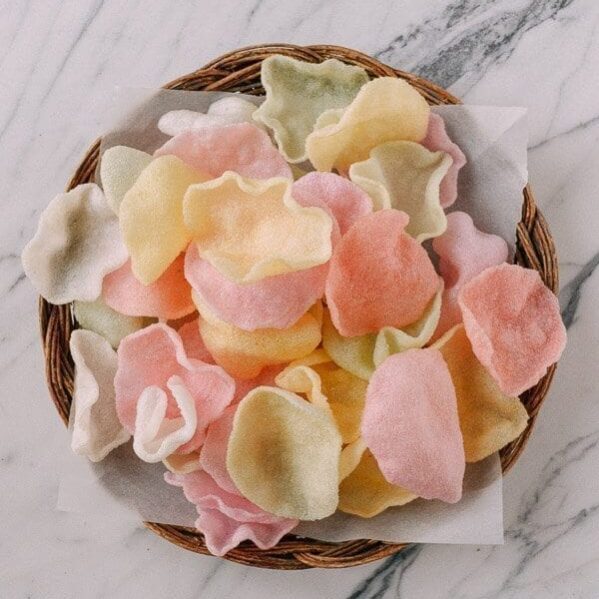
Ingredients
- 2 cups vegetable oil (for frying)
- 1 box shrimp or prawn flavored chips
Instructions
- Heat the oil to 325 degrees Fahrenheit, and adjust your burner to maintain a constant temperature. You can use a thermometer to monitor the oil temperature for optimum frying.
- Prepare a sheet pan by lining it with paper towels. You will also need a spider or a large spoon to handle the shrimp chips when frying.
- Place 8 to 10 chips in the spider and drop them into the hot oil. Give them a gentle stir. Almost immediately, you will see the chips expand and float to the top of the oil.
- Use your spider to quickly scoop them out of the oil before they get scorched or burned. Shake off as much of the excess oil as possible, and transfer them to your prepared sheet pan. Fry the chips in batches until you have enough, and transfer the cooled chips to a basket and serve.

